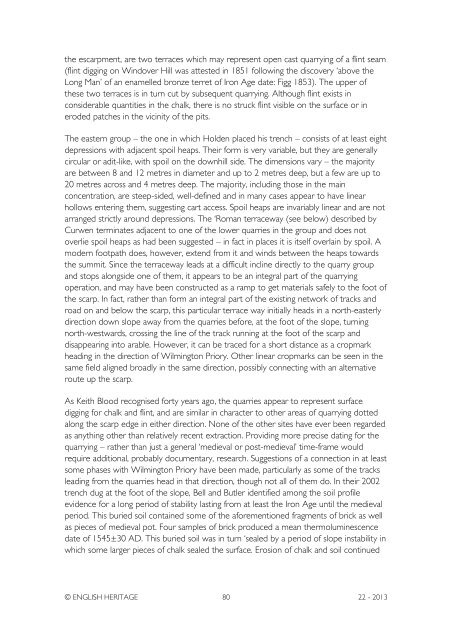Aerial Investigation and Mapping Report - English Heritage
Aerial Investigation and Mapping Report - English Heritage
Aerial Investigation and Mapping Report - English Heritage
You also want an ePaper? Increase the reach of your titles
YUMPU automatically turns print PDFs into web optimized ePapers that Google loves.
the escarpment, are two terraces which may represent open cast quarrying of a flint seam(flint digging on Windover Hill was attested in 1851 following the discovery ‘above theLong Man’ of an enamelled bronze terret of Iron Age date: Figg 1853). The upper ofthese two terraces is in turn cut by subsequent quarrying. Although flint exists inconsiderable quantities in the chalk, there is no struck flint visible on the surface or ineroded patches in the vicinity of the pits.The eastern group – the one in which Holden placed his trench – consists of at least eightdepressions with adjacent spoil heaps. Their form is very variable, but they are generallycircular or adit-like, with spoil on the downhill side. The dimensions vary – the majorityare between 8 <strong>and</strong> 12 metres in diameter <strong>and</strong> up to 2 metres deep, but a few are up to20 metres across <strong>and</strong> 4 metres deep. The majority, including those in the mainconcentration, are steep-sided, well-defined <strong>and</strong> in many cases appear to have linearhollows entering them, suggesting cart access. Spoil heaps are invariably linear <strong>and</strong> are notarranged strictly around depressions. The ‘Roman terraceway (see below) described byCurwen terminates adjacent to one of the lower quarries in the group <strong>and</strong> does notoverlie spoil heaps as had been suggested – in fact in places it is itself overlain by spoil. Amodern footpath does, however, extend from it <strong>and</strong> winds between the heaps towardsthe summit. Since the terraceway leads at a difficult incline directly to the quarry group<strong>and</strong> stops alongside one of them, it appears to be an integral part of the quarryingoperation, <strong>and</strong> may have been constructed as a ramp to get materials safely to the foot ofthe scarp. In fact, rather than form an integral part of the existing network of tracks <strong>and</strong>road on <strong>and</strong> below the scarp, this particular terrace way initially heads in a north-easterlydirection down slope away from the quarries before, at the foot of the slope, turningnorth-westwards, crossing the line of the track running at the foot of the scarp <strong>and</strong>disappearing into arable. However, it can be traced for a short distance as a cropmarkheading in the direction of Wilmington Priory. Other linear cropmarks can be seen in thesame field aligned broadly in the same direction, possibly connecting with an alternativeroute up the scarp.As Keith Blood recognised forty years ago, the quarries appear to represent surfacedigging for chalk <strong>and</strong> flint, <strong>and</strong> are similar in character to other areas of quarrying dottedalong the scarp edge in either direction. None of the other sites have ever been regardedas anything other than relatively recent extraction. Providing more precise dating for thequarrying – rather than just a general ‘medieval or post-medieval’ time-frame wouldrequire additional, probably documentary, research. Suggestions of a connection in at leastsome phases with Wilmington Priory have been made, particularly as some of the tracksleading from the quarries head in that direction, though not all of them do. In their 2002trench dug at the foot of the slope, Bell <strong>and</strong> Butler identified among the soil profileevidence for a long period of stability lasting from at least the Iron Age until the medievalperiod. This buried soil contained some of the aforementioned fragments of brick as wellas pieces of medieval pot. Four samples of brick produced a mean thermoluminescencedate of 1545±30 AD. This buried soil was in turn ‘sealed by a period of slope instability inwhich some larger pieces of chalk sealed the surface. Erosion of chalk <strong>and</strong> soil continued© ENGLISH HERITAGE 80 22 - 2013

















